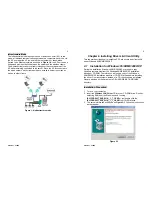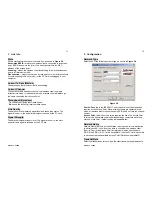
Version 1.7.37R2
23
Chapter 5. Product Specifications
General
Radio Data Rate
11, 5.5, 2 and 1 Mbps, Auto Fallback
Operating Voltage
3.3V/5V
Regulation Certifications
FCC Part 15/UL, ETSI 300/328/CE
Compatibility
Fully interoperable with IEEE802.11b compliant products
LED Indicator
RF Link activity
Network Information
Network Architecture
Support ad-hoc, peer-to-peer networks and
infrastructure communications to wired Ethernet networks via Access Point
Drivers
Windows 95/98/ME/2000/XP
Access Protocol
CSMA/CA
Roaming
IEEE802.11b compliant
Security
64/128-bit WEP data encryption
Radio
Frequency Band
2.4 – 2.484 GHz
Radio Type
Direct Sequence Spread Spectrum (DSSS)
Modulation
CCK (11, 5.5Mbps), DQPSK (2Mbps), DBPSK (1Mbps)
Operation Channels
11 for North America, 14 for Japan, 13 for Europe, 2
for Spain, 4 for France
RF Output Power
19dBm (WPC-8110), 13dBm (WPC-2110)
Sensitivity @FER=0.08
11 Mbps <-85dBm (WPC-8110), 83dBm(WPC-
2110)
5.5 Mbps<-88dBm (WPC-8110), 86dBm (WPC-2110)
2 Mbps <-91dBm (WPC-8110), 89dBm (WPC-2110)
1 Mbps <-93dBm (WPC-8110), 91dBm (WPC-2110)
Environmental
Temperature Range
0 to 55 C (operating), -20 to 75 C (storage)
Humidity
(non-condensing) 10% to 95% typical
Physical Specifications
Form Factor
PCMCIA Type II PC Card
Dimensions
118.5(L)mm * 54.5(W)mm * 9.2(H)mm
Weight
45 g
Version 1.7.37R2
24
Chapter 6. Regulatory Compliance Information
Radio Frequency Interference Requirements
This device complies with Part 15 of FCC Rules and Canada RSS-210.
Operation is subject to the following conditions:
1. This device may not cause harmful interference.
2. This device must accept any interference received, including interference that
may cause undesired operation.
3. To comply with RF safety requirements, you must maintain a distance of 20 cm
from the antenna when operating the device.
4. This transmitter must not be co-located or operating in conjunction with any
other antenna or transmitter.
Interference Statement
This equipment has been tested and found to comply with the limits for a
Class B digital device, pursuant to Part 15 of the FCC Rules, These limits
are designed to provide reasonable protection against harmful interference
in a residential installation. This equipment generates, uses and can radiate
radio frequency energy and, if not installed and used in accordance with the
instructions, may cause harmful interference to radio communications.
However, there is no guarantee that interference will not occur in a
particular installation. If this equipment does cause harmful interference to
radio or television reception, which can be determined by turning the
equipment off and on, the user is encouraged to try to correct the
interference by one of the following measures:
Reorient or relocate the receiving antenna.
Increase the separation between the equipment and receiver.
Connect the equipment into an outlet on a circuit different from that to
which the receiver is connected.
Consult the dealer or an experienced radio/TV technician for help.
FCC Caution
To assure continued compliance, (example – use only shielded interface
cables when connecting to computer or peripheral devices). Any changes
or modifications not expressly approved by the party responsible for
compliance could void the user’s authority to operate this equipment.
Manufacturer’s Declaration of Conformity
































